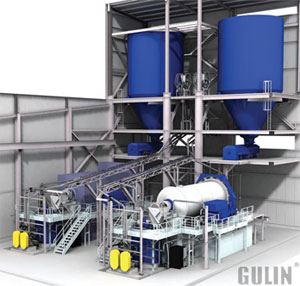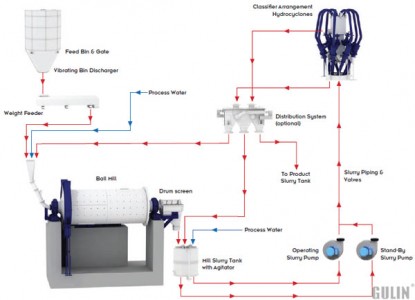wet limestone grinding mill
Wet grinding is usually preferred over dry grinding. When looking at the grinding process in isolation, there are pros and cons of wet versus dry. Dry grinding requires more power, yet has less ball and liner consumption that in wet grinding. Additionally, the capacity of a dry mill is typically less per unit mill volume than it is with wet milling.
However, it is the overall FGD system design and use requirements that push the selection in the direction of wet grinding. The two main reasons are that the ground product is utilized in a wet process and that the received condition of the stone can be one of relatively high moisture.
In addition to the higher dry milling energy required, when feed stone surface moisture rises above 2-3% by weight, a heated air source to accommodate drying is typically required. This usually leads to unacceptably high energy costs. Indeed, in most industries, the increased energy consumption and the capital cost of the equipment can swiftly move the overall economics away from dry grinding when a wet slurry is a desired end product.
A commonly specified FGD limestone size for feed to the mill system is 3/4” x 0”. This is a loose description of a size distribution which can be thought of as all of the particles smaller than 3/4” with the distribution extending into a fines range below 20 mesh. Size ranges described in this manner are variable in practice and can have occasional 1 to 3” tramp material and/ or higher percentages of fines. The horizontal ball mill is capable of accepting this stone size direct, without any pre-crushing function, thus improving system flexibility, simplicity and reliability. Abrasion is controlled with wear resistant mill liners and by the inherent concentration of the wear in the media.
Limestone grinding process
Firstly, big limestone block is crushed by jaw crusher to the size required, and then the crushed limestone is elevated into a hopper. Then the limestone is transported through the electro-magnetic vibrating feeder, evenly and continuously into the grinding chamber for powder-processing. The rollers oscillate outward to press the ring because of the centrifugal force and the shovel scoops up the materials, send to the middle between ring and roller to accomplish the grind.
After this, the ground limestone powder is carried by the air from the blower into the separator for screening. The fine powers are blow into the cyclone collector and are poured out through the output-powder valve as the final products and the rough stuff after the screening will be recycled back into the grinding chamber for regrinding.
Limestone Screening Solution
Gulin supply complete set of screening plant in tracked, wheeled, stationary type for the contractors. We also provide our customers tailor made plants and mobile screening plant to suit different factors such as application, capacity and site conditions.
Limestone Grinding Case in India
As a material supplier for a paper making company, a factory from India needs a mill to get limestone powder. The required output size is D90=105μm, required capacity is 3-5t/h. Since this client just needs medium output size, our MTM Medium Speed Trapezium Mill will be suitable for him; and the required capacity is low, so the small model MTM100 is his best choice. Under guidance of our engineer, they have finished the installation and commissioning. The classifier is adjusted for required size and the capacity has reach to more than 4t/h. Now the plant is running stably with good performance.



